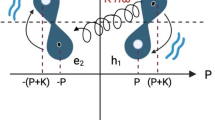Abstract
Gilbert has suggested that the presence of intervening sequences in DNA, called introns, can speed evolution by allowing novel proteins to be constructed from the pieces of existing ones1. This hypothesis further suggests that the coding sequences, called exons, correspond to functional parts of the protein. The most striking example so far is the case of the immunoglobulin γ heavy chain, where the four polypeptide sequences corresponding to the four coding sequences form structurally and functionally distinct parts of the molecule1,2. The relation between the three coding sequences of the β globin gene and structure or function is not as obvious, but the central coding sequence does code for the part of the globin chain which forms the haem crevice3,4. To further test the idea that coding sequences correspond to functional units of proteins we consider the relationship between the coding sequences of α and β globin genes and the corresponding parts of the complete, tetrameric haemoglobin molecule.
This is a preview of subscription content, access via your institution
Access options
Subscribe to this journal
Receive 51 print issues and online access
$199.00 per year
only $3.90 per issue
Buy this article
- Purchase on Springer Link
- Instant access to full article PDF
Prices may be subject to local taxes which are calculated during checkout
Similar content being viewed by others
References
Gilbert, W. Nature 271, 501 (1978).
Sakano, H. et al. Nature 277, 627 (1979).
Blake, C. C. F. Nature 277, 598 (1979).
Gilbert, W. in Eukaryotic Gene Regulation, ICN-UCLA Symposium on Molecular and Cellular Biology Vol. 14 (eds Axel, R., Maniatis, T. & Fox, C. F.) 1–10 (Academic, New York, 1979).
Monod, J., Wyman, J. & Changeux, J. P. J. molec. Biol. 12, 88 (1965).
Perutz, M. F. Nature 228, 726 (1970).
Shulman, R. G., Hopfield, J. J. & Ogawa, S. Q. Rev. Biophys. 8, 325 (1975).
Szabo, A. & Karplus, M. J. molec. Biol. 72, 163 (1972).
Edelstein, S. J. A. Rev. Biochem. 44, 209 (1976).
Perutz, M. F. A. Rev. Biochem. 48, 327 (1979).
Baldwin, J. & Chothia, C. J. molec. Biol. 129, 175 (1979).
Perutz, M. F. & Lehmann, H. Nature 219, 902 (1968).
Greer, J. Cold Spring Harb. Symp. quant. Biol. 36, 315 (1971).
Fermi, G. J. molec. Biol. 97, 237 (1975).
Goodman, M., Moore, G. W. & Matsuda, G. Nature 253, 603 (1975).
Arnone, A. Nature 237, 146 (1972).
Matthew, J. B., Hanania, G. I. H. & Gurd, F. R. N. Biochemistry 18, 1928 (1979).
List of haemoglobin variants Hemoglobin 1, 601 (1977).
List of haemoglobin variants Hemoglobin 1, 707 (1977).
Gelin, B. & Karplus, M. Proc. natn. Acad. Sci. U.S.A. 74, 801 (1977).
Riggs, A. Fedn Proc. 35, 2115 (1976).
Leder, A. et al. Proc. natn. Acad. Sci. U.S.A. 75, 6187 (1978).
Nishioka, Y. & Leder, P. Cell 18, 875 (1979).
Van den Berg, J. et al. Nature 276, 37 (1978).
Konkel, D. A., Tilghmann, S. M. & Leder, P. Cell 15, 1125 (1978).
Li, S. L. & Riggs, A. J. biol Chem. 245, 6149 (1970).
Love, W. E. et al. Cold Spring Harb. Symp. quant. Biol. 36, 349 (1971).
Bucci, C. F. & Bucci, E. Biochemistry 14, 4451 (1975).
Winslow, R. M. & Anderson, W. F. The Metabolic Basis of Inherited Disease (eds Stanbury, J. B., Wyngaarden, J. B. & Frederickson, D. S.) 1465–1507 (McGraw-Hill, New York, 1978).
Author information
Authors and Affiliations
Rights and permissions
About this article
Cite this article
Eaton, W. The relationship between coding sequences and function in haemoglobin. Nature 284, 183–185 (1980). https://doi.org/10.1038/284183a0
Received:
Accepted:
Issue Date:
DOI: https://doi.org/10.1038/284183a0
This article is cited by
-
Introns and higher-order structure in the evolution of serpins
Journal of Molecular Evolution (1993)
-
General relationships of mammalian orders and evolutionary development of primates inferred from best-fit α-globin phylogenies
Journal of Biosciences (1987)
-
Aspects of biological evolution based on molecular data sets
Proceedings: Animal Sciences (1984)
-
Gene and protein structure of a β-crystallin polypeptide in murine lens: relationship of exons and structural motifs
Nature (1983)
-
The seal myoglobin gene: an unusually long globin gene
Nature (1983)
Comments
By submitting a comment you agree to abide by our Terms and Community Guidelines. If you find something abusive or that does not comply with our terms or guidelines please flag it as inappropriate.



